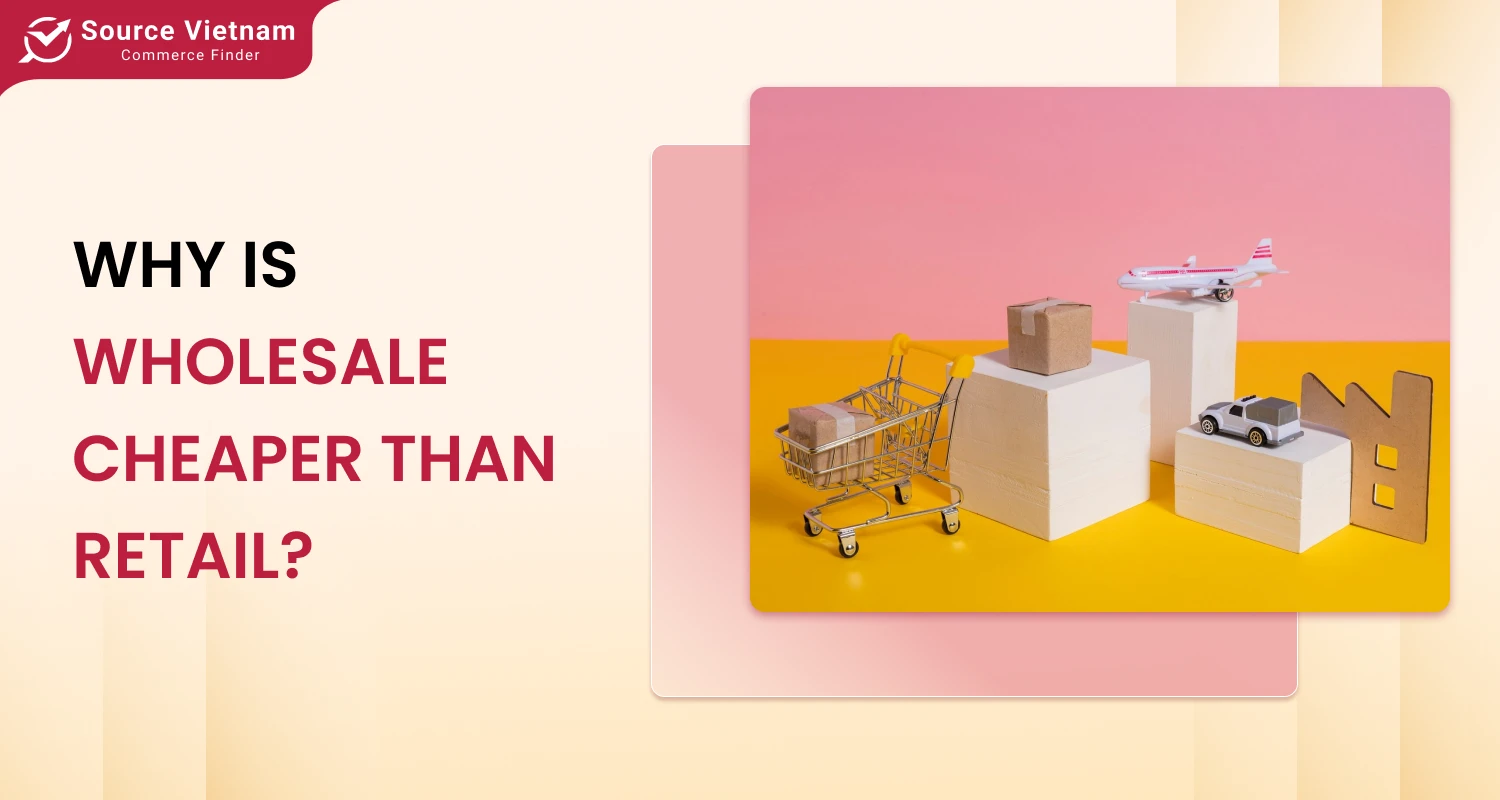In this era of developing eCommerce businesses, wholesale vs retail pricing are two key pricing concepts for businesses to understand. All the customers should know that wholesale pricing is cheaper than retail prices. There are several reasons for this case, including that wholesale prices are frequently based on bigger product quantities and are intended to be more competitive.

This article will explain why wholesale is cheaper, providing insight into how economies of scale and supplier relationships contribute to lower wholesale prices.
What is wholesale pricing?
Wholesale pricing involves offering products or services directly to retailers or other enterprises at a reduced cost. By encouraging businesses to buy in large numbers, this wholesale pricing strategy can assist suppliers or providers in moving inventory more effectively and rapidly.
Wholesale is cheaper than retail because the retailers mark up the product before selling it to the final customers.

Wholesale industries, comprising distribution, manufacturing, and retail, frequently apply wholesale pricing to sell goods in larger quantities. It can be a useful wholesale pricing strategy for companies looking to improve sales and strengthen partnerships with their partners.
How do economies of scale drive lower prices?
The economy of scale is the main reason why wholesale is cheaper. Economies of scale occur when a company experiences a decrease in its average cost per unit as it increases its production volume. Below is a full explanation of how economies of scale drive lower prices.
Bulk buying and cost efficiency
Economies of scale represent an economic principle that categorizes them as a form of efficiency. This is because they are linked to continuous improvements in production efficiency as a business grows in size and scope.
The efficiencies that result from economies of scale usually include making the best use of labor, raw materials, and machinery; implementing more efficient technologies; getting rid of unnecessary procedures; negotiating better terms with suppliers to increase efficiency by acquiring inputs at lower costs; making the most of facilities and equipment, among other things.

Besides that, about 10% of a product’s cost savings are related to its packaging. However, less packaging is needed when things are packaged in large quantities.
Moreover, less packing waste results from this reduction, which benefits both the producer and the customer. Economies of scale refer to the cost savings advantages of bulk buying through wholesale that companies can achieve when they increase their production output or expand their operations.
Lower per-unit costs
In addition, the cost per unit is normally far cheaper than a wholesaler. This is because a wholesaler acquires stock and purchases large quantities at prices that would likely be unavailable to retailers and the general public. Producers and manufacturers determine the wholesale price, and retailers will determine the cost they will sell to the consumer, largely dependent on the fee they pay per unit from the wholesaler.
Although the increase from wholesale to retail price differs and depends on many factors, retailers generally hike the cost per unit by two times the wholesale price. That is why wholesale prices are lower than retail prices.
Retail markup vs. wholesale margins
How retailers mark up prices
Retail pricing is a pricing method that involves marking up the price of a good or service before it is sold directly to the customer. Retail prices are higher than wholesale prices because the retailer marks up the product to cover operating costs and profit wholesale margins. Businesses that sell directly to customers, such as physical stores, online merchants, and service providers, often use this pricing method.

Retail prices vary depending on the product or service sold and are often influenced by supply and demand, competition, and customer preferences. Any company’s pricing plan must include establishing an accurate retail price because it directly impacts revenue and profits.
Wholesale margins and profitability
Businesses need economies of scale because they can boost their competitiveness and profitability. They can offer their goods and services at a reduced cost per unit, drawing in more clients and expanding their market share. Additionally, by enabling businesses to expand their operations, invest in R&D, or enter new markets, economies of scale can give them a competitive edge, which is how wholesale suppliers offer lower prices.

Suppliers are generally willing to reduce prices and take a smaller margin when you buy in bulk since they know the sale will be guaranteed. It’s much better than having a warehouse full of unsold inventory.
In general, they would prefer to sell more items for a lower profit than to have clothing lying in a warehouse, gathering dust or losing money on already manufactured goods. Additionally, because they’re shipping out many orders simultaneously, they can keep their inventory turnover ratio high. That is how wholesale pricing works.
Read more: What Is the Key Difference Between Wholesale and Retail?
Benefits of buying wholesale
There is more than one reason why most companies buy in bulk. Even small businesses can reap the benefits of purchasing wholesale products they need in large quantities. But what makes bulk buying so advantageous? Here are some of the ways it could transform your business.
Lower costs for businesses
As mentioned earlier, wholesalers offer goods at a discounted price when you buy in bulk directly from them- cutting out the middleman. These discounted prices give great cost savings, which you can pass on to your customers by keeping operating costs low and increasing profit margins! Operating costs include the cost of goods sold (COGS) and other costs such as rent, utilities, etc.

Plus, when buying wholesale, the cost per unit of each item decreases, as well as reduced shipping costs per unit, which makes it a much more economical process. These savings you make allow you to be more flexible in pricing, meaning retailers can offer volume discounts & lower prices while still keeping a good profit margin.
Flexibility and scalability
Because the companies you sell to purchase in bulk, your brand will deal with more transactions overall when you sell wholesale products. You have a decent probability of growing your business as a result. Scalability may be supported by the wholesale business model’s ability to generate more income and lower expenses per unit.
Additionally, it is simpler to provide outstanding customer service because of your tiny clientele and high revenue per customer. You could create a hotline with specialized account managers using your call center software. This might not be feasible in a retail business model.
Read more: Differences Between Dropshipping and Wholesale Explained
Key differences between wholesale vs retail pricing models
Pricing structures
Similar to the information above, the wholesale price is charged to retailers by the manufacturer or distributor. The retailers then charge customers the same product at the retail price. That is why wholesale is cheaper.

Wholesale pricing refers to the price at which goods or products are sold to retailers or other businesses for resale. It is typically lower than the retail price, allowing retailers to mark up the products and profit when selling them to end consumers.
And, retail pricing refers to the price at which products or goods are sold directly to end consumers in a retail setting. It is the price that customers pay when purchasing products from a retailer or a store. On the other hand, retail price includes a markup to cover the retailer’s expenses and profit margin, unlike wholesale prices.
Target audience and buyer relationships
Belongs to the differences between wholesale and retail pricing models, as previous information above. Under the wholesale pricing model, companies sell their goods to wholesale suppliers or retailers at a set price, and these retailers resell the goods to final consumers. Usually, a markup for profit is added to the production cost to determine the price.
The business-to-business (B2B) industry typically uses this wholesale pricing model to purchase goods in bulk or at wholesale prices.

In contrast, the retail pricing model involves marking up the cost of production to sell directly to the end consumer. This pricing strategy, mostly used in business-to-consumer (B2C) markets, allows companies to determine the price they think their target consumers are willing to pay. Retailers may also use promotional pricing to boost sales and attract customers, such as volume discounts or sales.
Risks and challenges of wholesale purchasing
Now you understand why wholesale is cheaper than retail, let’s move to the challenges of buying in bulk. The wholesale industry plays a crucial role in the global economy by supplying goods and materials to businesses and institutions. However, the industry faces several challenges that can affect profitability:
- Inventory management: One of the pillars of wholesale business is efficient inventory management. Overstocking can cause higher holding costs and lower cash flows. Meanwhile, understocking may lead to product shortages, resulting in missed sales opportunities that eventually drive away potential customers. The client satisfaction level will be low due to a lack of supply.

- Wholesale pricing strategy: The pricing strategies are challenging in a market where demand is volatile and customers’s expectations differ. Wholesale businesses always have to walk a tightrope between providing tempting discounts for their clients, even if some of them are only looking for a wholesaler offering small businesses goods at low prices and keeping healthy profit margins.
- Customer relationship management: Businesses that rely heavily on wholesale pricing may become overly dependent on a few large customers, which can be risky if they decide to reduce their orders or switch to a competitor.
TOP 6 brands operating in both wholesale and retail
SourceVietnam.com
SourceVietnam.com is the leading wholesale platform in Vietnam, connecting global buyers with trusted suppliers. This platform offers reliable and quality local product sourcing at a reasonable price. As a marketplace, SourceVietnam.com enables businesses and individual entrepreneurs to purchase directly from manufacturers at wholesale prices.

Costco
Costco is one of the biggest stores that offers high-quality, name-brand goods at significantly cheaper costs than traditional wholesale or retail sources. The warehouses are intended to assist small and medium-sized enterprises lower the expenses of buying goods for regular business usage and selling.

Alibaba
Alibaba is a shining example of a wholesale and retail company, providing a full omnichannel experience. Alibaba functions as a marketplace that allows companies and individual business owners to buy directly from producers at discounted costs. After choosing the products they want, sellers may get in touch with suppliers, haggle over costs, and make orders with the guarantee of timely delivery to start selling.

Walmart
Walmart is a wholesale and retail business model in the US online B2B and B2C marketplace. It is an essential platform that connects different companies worldwide. Walmart provides a wide range of features at the best price to meet the needs of international clients. The company has an incredible roster of over 10,500 locations and various eCommerce websites in 19 countries.

Sam’s Club
Sam’s Club is the best location for wholesalers who offer discounted costs to clients doing bulk orders. This supply chain of supermarkets specializes in warehousing and wholesale for Americans. It is a place to buy everything from fashion items to repair supplies and everyday essentials. Currently, Sam’s Club boasts 602 locations throughout the US and up to 47 million members.

Amazon
Amazon is an eCommerce site that sells millions of items in various categories, including electronics, jewelry, apparel, toys, accessories, books, and home appliances, as a business supply chain. Additionally, Amazon offers several alluring sales and volume discounts to assist customers in reducing the cost of their purchases.

Conclusion
This article comprehensively explains why wholesale is cheaper than retail, that wholesale prices are frequently based on bigger product quantities, and that a wholesaler acquires stock from providers and manufacturers at a reduced rate.
Although wholesale is cheaper than retail, wholesalers face potential risks such as inventory management, pricing strategy, and customer relationship management. By understanding the differences and benefits, you can choose the suitable model for your business to achieve your goals.
FAQs
What is the primary reason wholesale prices are lower than retail prices?
Wholesale prices are lower than retail prices primarily because wholesalers sell in bulk to retailers, allowing them to offer lower per-unit costs. This bulk purchasing reduces the overall cost of goods sold, enabling wholesalers to pass on savings to retailers who then mark up the price for consumers.
How do economies of scale affect wholesale pricing?
Production becomes more efficient when multiple units of a product are manufactured simultaneously. In other words, producers use less labor, fewer resources, and less time per unit. This is referred to as economies of scale, and many businesses are pleased to provide bulk pricing to customers to pass along the savings from large production runs.
Can small businesses benefit from buying wholesale?
Yes. Even small businesses can reap the benefits of buying wholesale products they need in large quantities. Wholesalers offer goods at a discounted price when you buy in bulk directly from them- cutting out the middleman.
These discounted prices give great savings, which you can pass on to your customers by keeping operating costs low and increasing profit margins. Besides that, flexibility and scalability may be supported by the business model’s ability to generate more income and lower expenses per unit.
How does market demand affect wholesale and retail pricing?
Market demand significantly influences both wholesale and retail pricing. When demand for a product increases, wholesalers may raise their prices due to higher production costs or limited supply. Retailers may also adjust their prices based on consumer demand, often increasing their markup during high-demand periods to maximize profits.
Are wholesale prices fixed, or can they vary?
Wholesale prices can vary based on several factors, including order volume, negotiation between the wholesaler and retailer, and market demand. While there is often a standard pricing structure, many wholesalers are open to negotiation, especially for large orders or long-term contracts.














